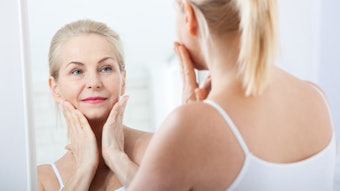The National Rosacea Society (NRS) has designated April as Rosacea Awareness Month to alert the public to the early warning signs of this chronic facial disorder, which is now estimated to impact more than 16 million Americans.
Fortunately, for individuals who recognize rosacea’s warning signs and seek medical help, diagnosis and appropriate therapy can bring their signs and symptoms under control and keep its social and emotional effects at bay.
Most rosacea patients feel the negative social impact of their condition
According to a new patient survey conducted by the NRS, most rosacea patients feel the negative social impact of their condition regardless of which rosacea subtype they may have. While 61% of those with only subtype 1 (erythematotelangiectatic) rosacea, characterized by facial redness, said their rosacea had inhibited their social lives, the number rose to 72% among those who reported their redness was moderate or severe.
Seventy-seven percent of patients with the bumps and pimples of subtype 2 (papulopustular) rosacea alone noted that their social life had been negatively impacted, and 85% of patients whose symptoms included subtype 3 (phymatous) rosacea, involving thickening of the skin, had been negatively affected. Among the respondents who had the eye irritation of subtype 4 (ocular) rosacea, 71% said the disorder’s effects had inhibited their social lives. The most common complaint, cited by 50% of the 801 respondents, was having to refuse food or drink they normally would enjoy for fear of triggering a rosacea flare-up.
Of those surveyed, 43% percent said they had been the subject of stares, misconceptions, rude comments or jokes, and 39% had refused or canceled social engagements because of rosacea’s effects on appearance. Other common complaints included not participating in physical activities they would enjoy, reported by 37% and avoiding new or different experiences, cited by 28%.
“The good news is that medical therapy, combined with trigger avoidance, can help to reduce rosacea’s impact on most patients,” said Dr. Mark Dahl, chairman of the NRS Medical Advisory Board.
Survey results show respondents' social lives improve with medical therapy
In fact, the survey results showed that 63% of the respondents reported improvement in their social lives following medical therapy.
During Rosacea Awareness Month and throughout the year, the NRS will conduct public education activities to reach the millions of rosacea sufferers who may not realize they have a medical condition that can be treated, emphasizing the warning signs and urging those who suspect they may have rosacea to see a dermatologist. Bulk quantities of educational materials are available to health professionals for their patients through the NRS website at www.rosacea.org.
Although rosacea varies from one patient to another, the primary signs may include flushing or transient erythema (redness), persistent or nontransient erythema, papules (bumps) and pustules (pimples), or telangiectasia (visible blood vessels), according to the NRS standard classification of rosacea, developed by a consensus committee and review panel of 17 experts worldwide.
Secondary features may include burning or stinging, plaques (raised patches on the skin), a dry appearance, edema (swelling), ocular manifestations and phymatous changes, in which the skin thickens. The standard subtypes of rosacea reflect the most common patterns of signs and symptoms, and characteristics of more than one subtype may occur at the same time.
Subtype 1 (erythematotelangiectatic) rosacea is characterized by flushing and persistent redness on the central portion of the face, while subtype 2 (papulopustular) rosacea also features papules and pustules. Subtype 3 (phymatous) rosacea includes thickening of the skin, irregular nodularities and enlargement, especially of the nose.
Subtype 4 is ocular rosacea, where the eyes may have a watery or bloodshot appearance, the sensation of a foreign body, burning or stinging, dryness, itching, light sensitivity or a host of other signs and symptoms.
During April and throughout the year, individuals may call the National Rosacea Society’s toll-free telephone number at 1-888-NO-BLUSH for information.
The NRS offers Rosacea Review, a newsletter for rosacea patients; a “Rosacea Diary” to help patients identify and avoid lifestyle factors that may trigger flare-ups in their individual cases; and other booklets to help patients understand and manage their condition. Information is also available by visiting the NRS website at www.rosacea.org; writing the National Rosacea Society, 196 James Street, Barrington, Illinois 60010; or via e-mail at [email protected].










